
Circumcision knives (Hebrew: אזמל izmel)
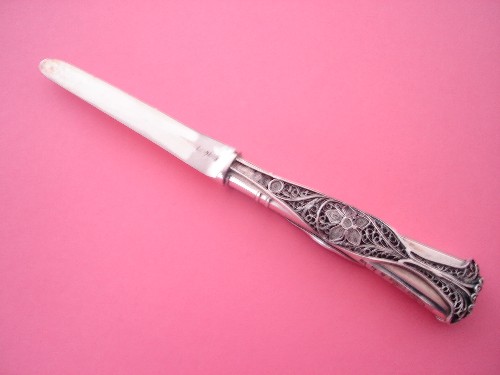
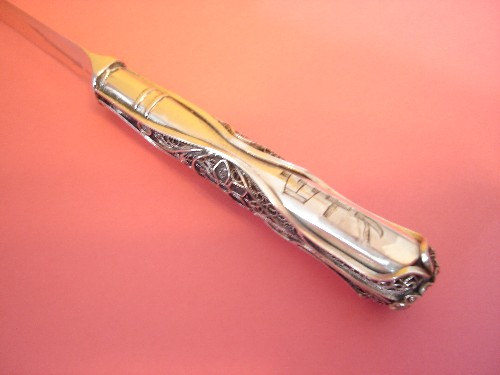 This
silver filigree knife was my first purchase. It was
listed as Russian, circa 1900. The blade is stamped "84"
and "AC." The handle is inscribed with three Hebrew
letters: zayin,
dalet, and shin. The seller
was from Poland.
This
silver filigree knife was my first purchase. It was
listed as Russian, circa 1900. The blade is stamped "84"
and "AC." The handle is inscribed with three Hebrew
letters: zayin,
dalet, and shin. The seller
was from Poland.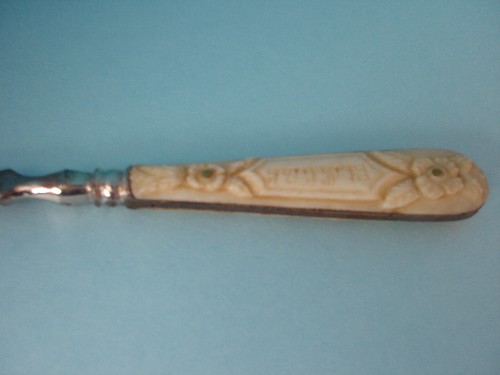
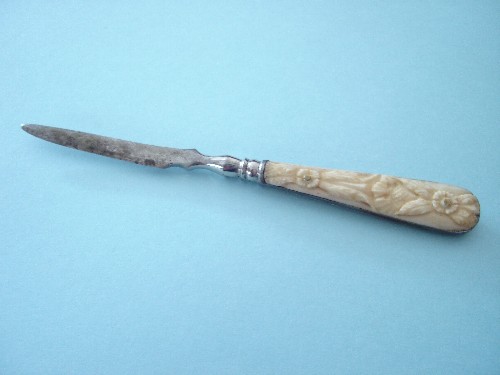 This knife on the right has an ivory handle.
It was listed as a "very old circumcision knife." The
blade is steel. The handle has a Hebrew inscription
that is hard to read. I think it spells brit milah. The
seller was from Poland.
This knife on the right has an ivory handle.
It was listed as a "very old circumcision knife." The
blade is steel. The handle has a Hebrew inscription
that is hard to read. I think it spells brit milah. The
seller was from Poland. This knife has some similarities to the last
one. Its handle is also ivory. The blade is
iron and brass. The seller listed the knife as
Polish, either 18th or 19th century.
This knife has some similarities to the last
one. Its handle is also ivory. The blade is
iron and brass. The seller listed the knife as
Polish, either 18th or 19th century.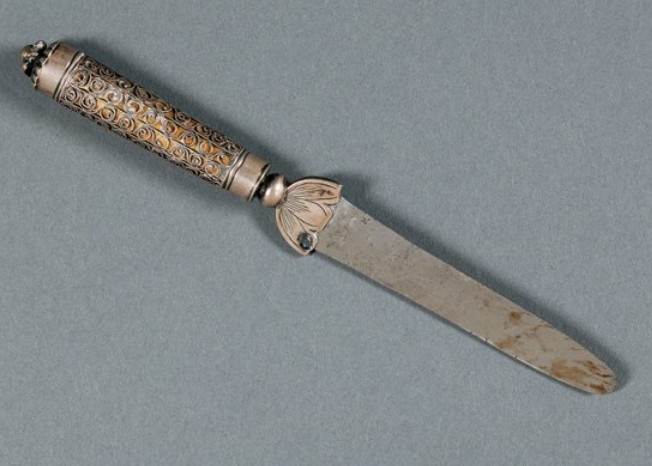 This is a stunning Polish
silver circumcision knife. The markings are early
19th century. The silver-gilt cylindrical handle
is adorned with filigree. There is a foliate
finial.
This is a stunning Polish
silver circumcision knife. The markings are early
19th century. The silver-gilt cylindrical handle
is adorned with filigree. There is a foliate
finial.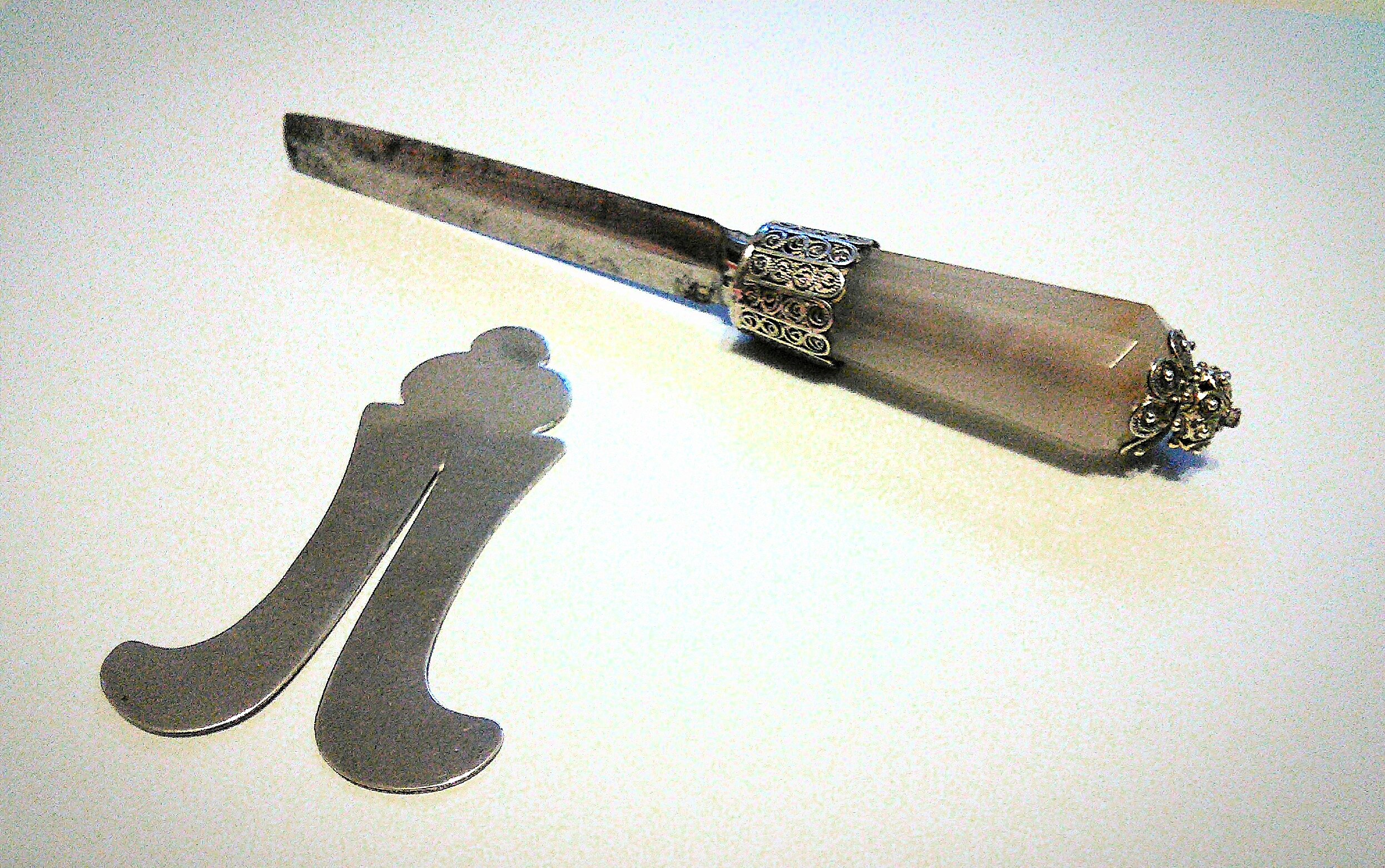 The knife on the right weighs a
substantial 45 grams due to the quartz handle. It
measures 15 centimeters. The silver filigree work
is exquisite. Its origin is likely Germany or
Poland, c. 1720 to 1780.
The knife on the right weighs a
substantial 45 grams due to the quartz handle. It
measures 15 centimeters. The silver filigree work
is exquisite. Its origin is likely Germany or
Poland, c. 1720 to 1780.Many thanks to the kind British gentleman who offered CircCentral this knife and silver shield from his grandfather's Judaica collection.
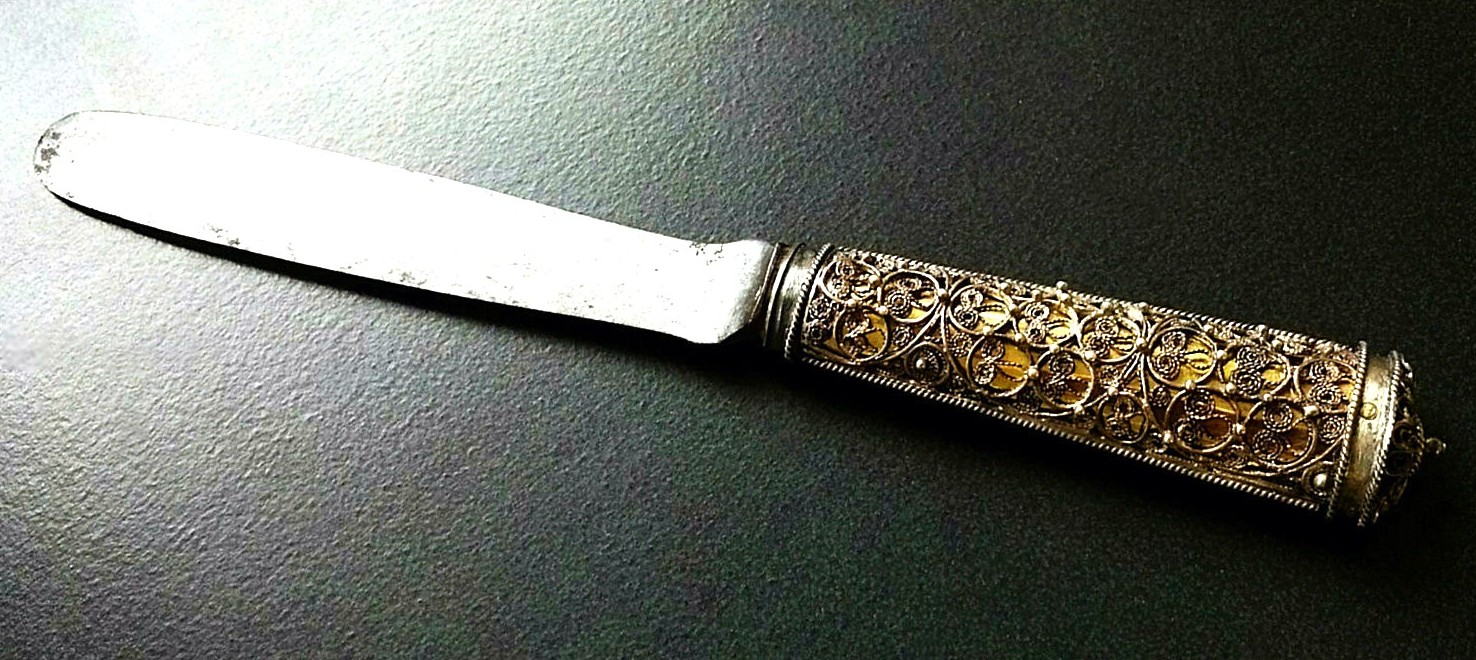 The circumcision
knife on the left was sold by a Scandinavian antiques
dealer. The close-up photo below it highlights the
beautiful gilding and filigree work. The knife is
likely Swedish, from the 17th or 18th century.
The circumcision
knife on the left was sold by a Scandinavian antiques
dealer. The close-up photo below it highlights the
beautiful gilding and filigree work. The knife is
likely Swedish, from the 17th or 18th century. 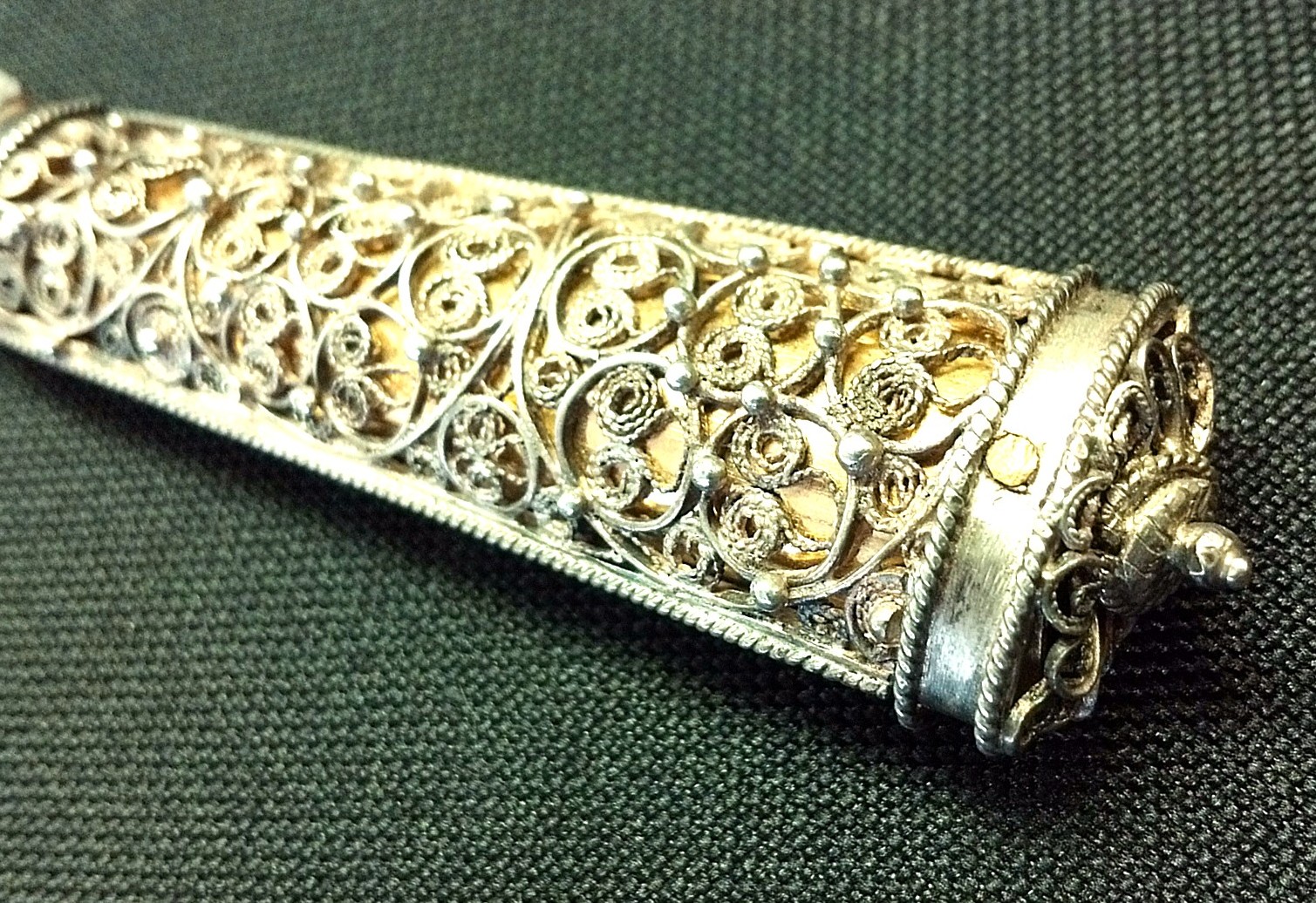
 Here is a
magnificent German silver knife with gilding on the
handle. The Hebrew inscription identifies the knife as
belonging to Rabbi Meir, son of Rabbi Moses, in 1806.
Here is a
magnificent German silver knife with gilding on the
handle. The Hebrew inscription identifies the knife as
belonging to Rabbi Meir, son of Rabbi Moses, in 1806. 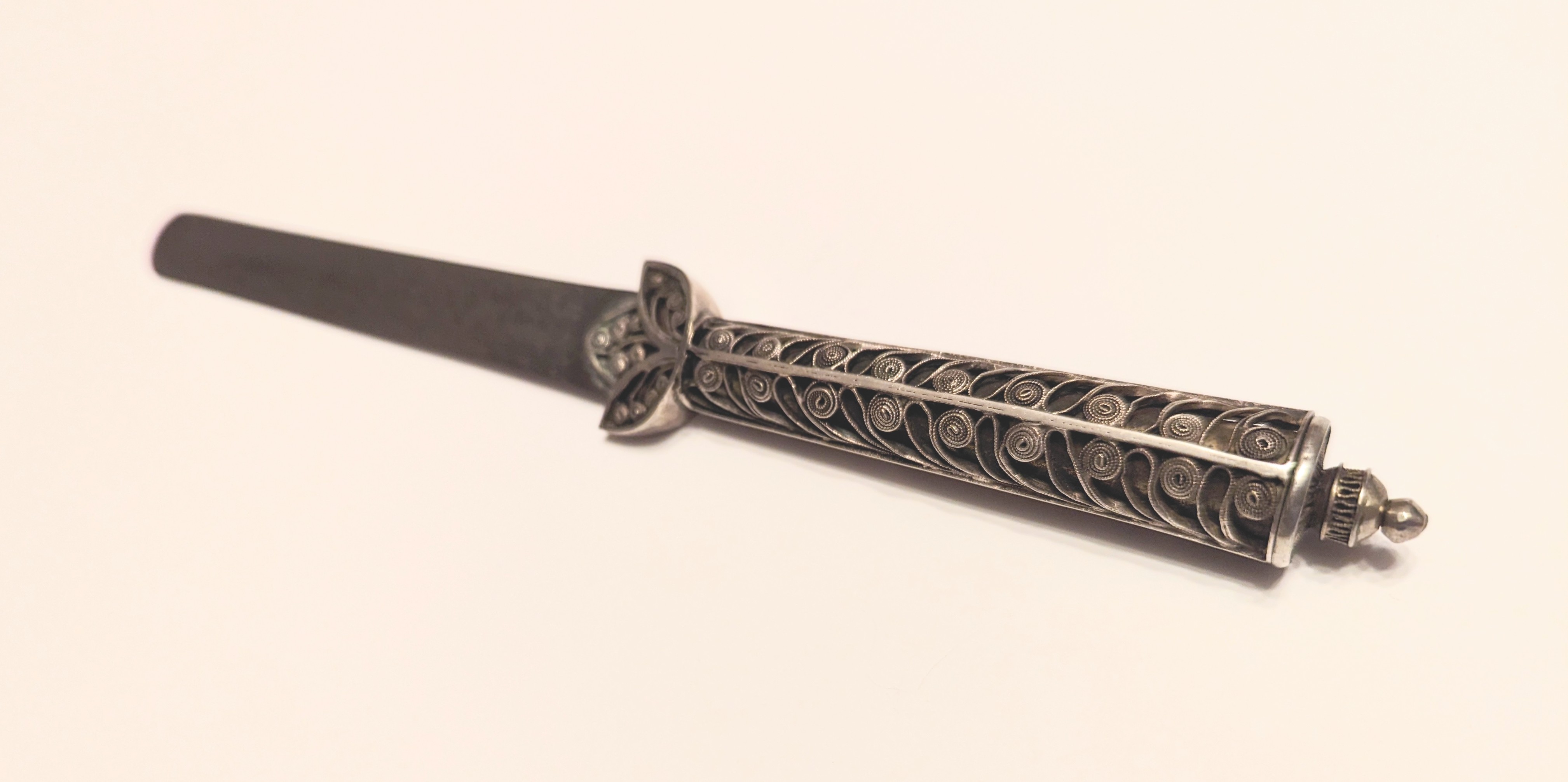 To the left is
a filigree-handled knife from Eastern Europe, circa
1800.
To the left is
a filigree-handled knife from Eastern Europe, circa
1800. To the right is yet another exquisite
knife with a filigree handle. The knife is likely
Polish and from the early 18th century.
To the right is yet another exquisite
knife with a filigree handle. The knife is likely
Polish and from the early 18th century.Although the other knives on this page have double-sided blades, this knife's blade is sharpened on just one side. The agate handle makes this knife a bit heavier than the others.
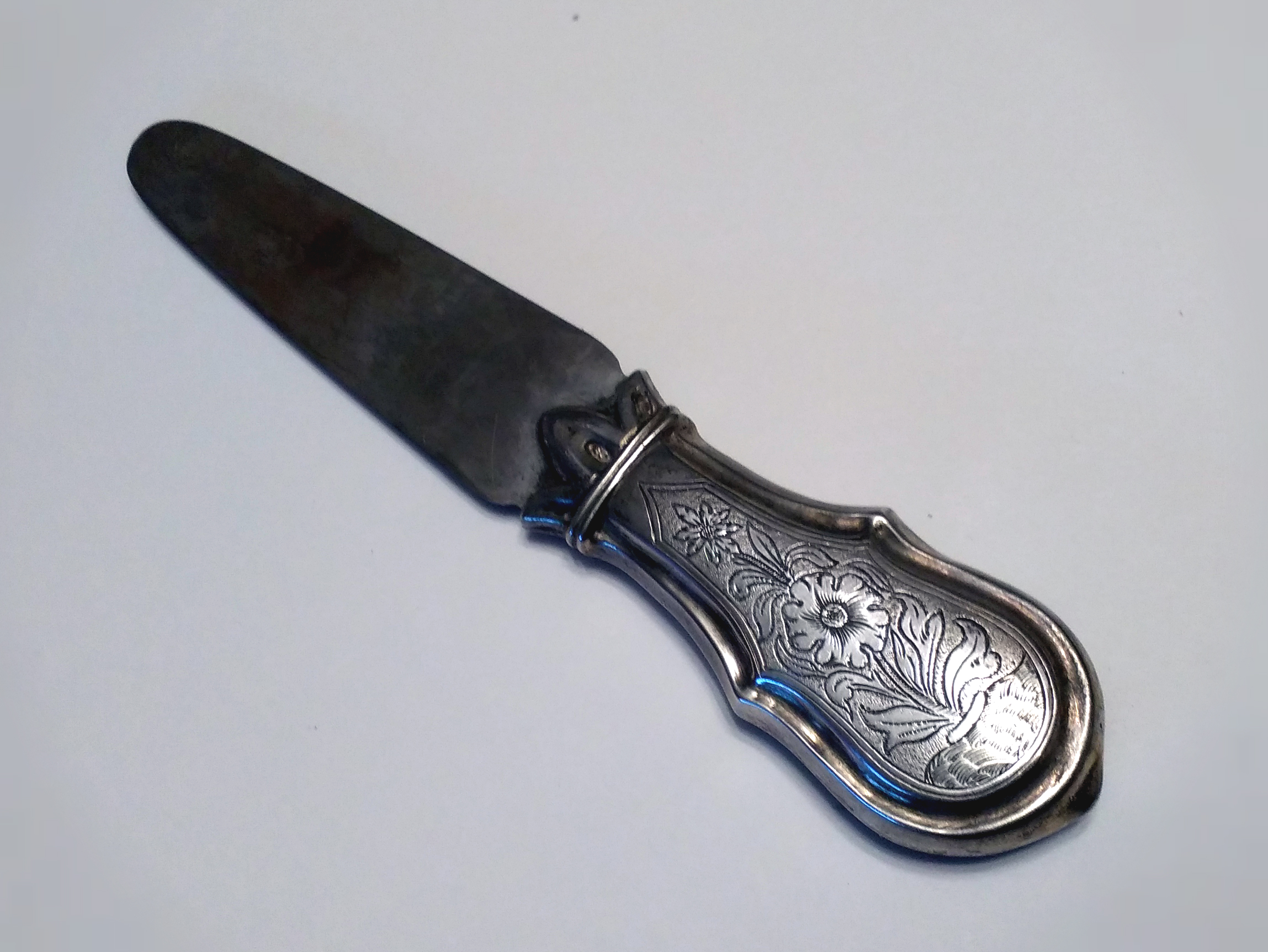
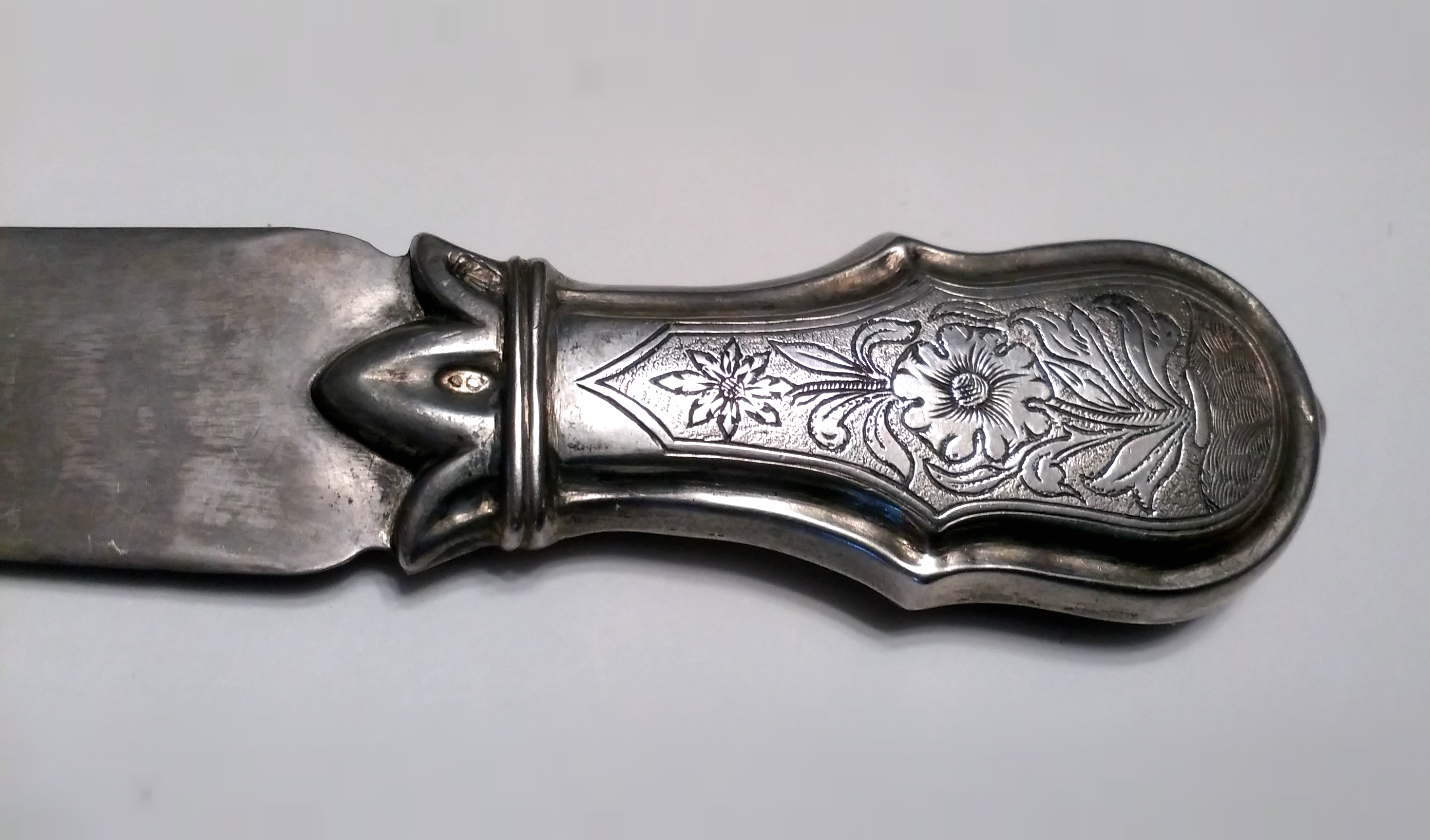
Above is a 19th century silver German circumcision knife with ornate floral and foliate engravings.
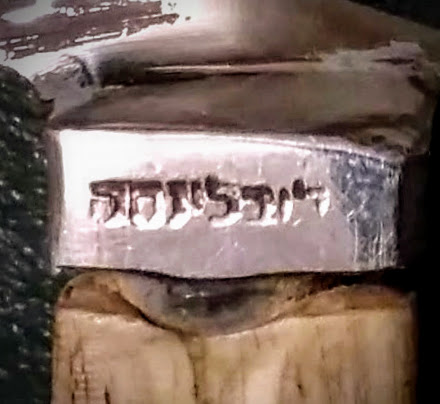
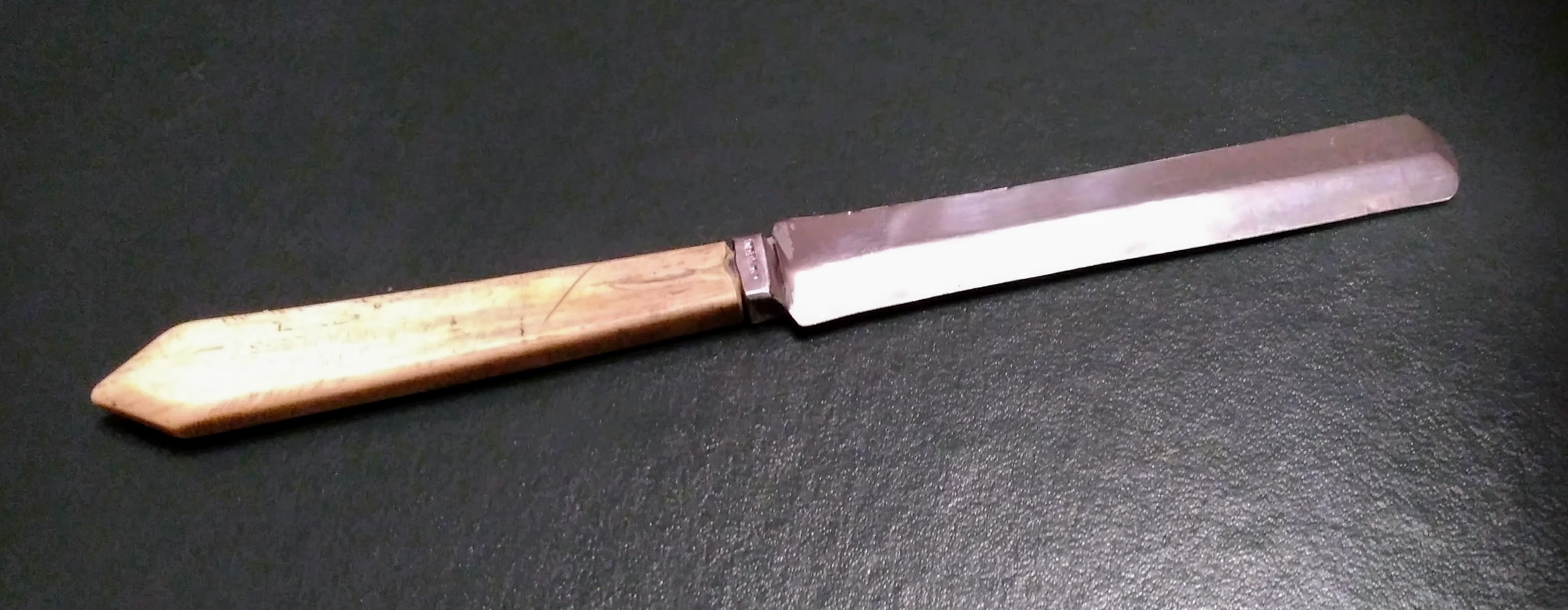
To the
right is a utilitarian mid-20th century knife from Dov
Lublinsky's shop in Tel Aviv, Israel. Mr. Lublinsky
immigrated from Poland and in 1938 started the premier
knife shop in Israel. Lublinsky
is now run by his son Shraga and remains the best
place in Israel to buy knives.
Click here
to read a nice article about this family.

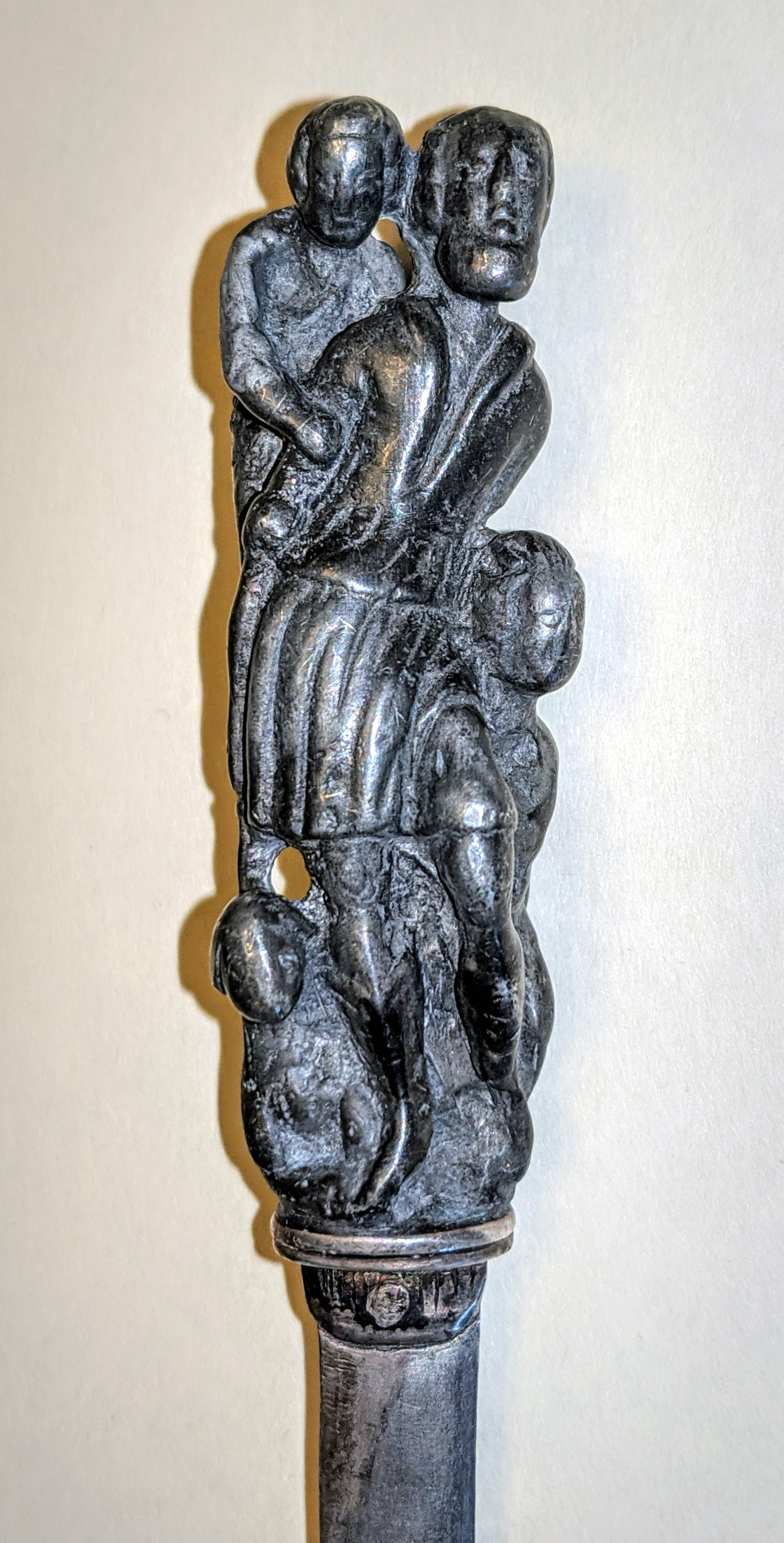 The interesting
circumcision knife to the left has a handle which
depicts the binding of Isaac as written in Genesis. The
Israeli auction house suggested that the knife
originated from 18th century Europe.
The interesting
circumcision knife to the left has a handle which
depicts the binding of Isaac as written in Genesis. The
Israeli auction house suggested that the knife
originated from 18th century Europe. A year prior another auctioneer offered the same knife and dated it as 20th century. The lack of fine detail on the handle makes this a more likely assessment.
A Brooklyn auction house listed the knife below as a "very old circumcision knife, most likely Sephardic in origin." I was told the handle is gilded silver. On two sides of the handle are Hebrew inscriptions which are too worn to read. On the other two sides are floral decorations.
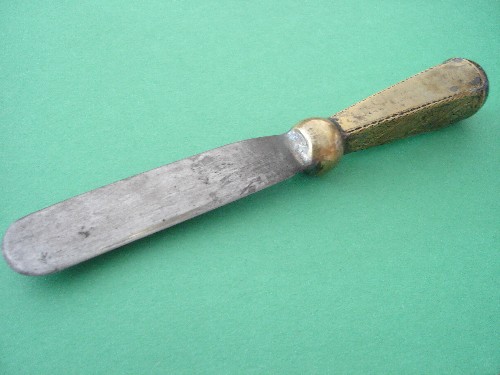
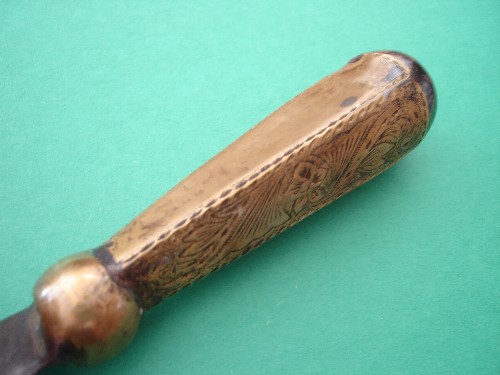
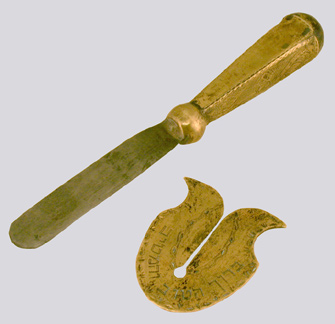 I
discovered that a different auction house sold what
appears to be the exact same knife (along with a shield)
six months prior. In that listing, the knife was
described as brass, Eastern European, mid-19th
century. Interesting!
I
discovered that a different auction house sold what
appears to be the exact same knife (along with a shield)
six months prior. In that listing, the knife was
described as brass, Eastern European, mid-19th
century. Interesting!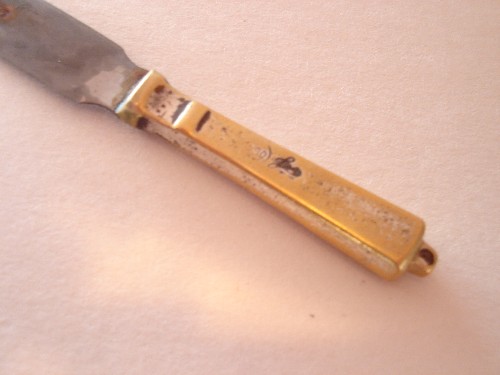
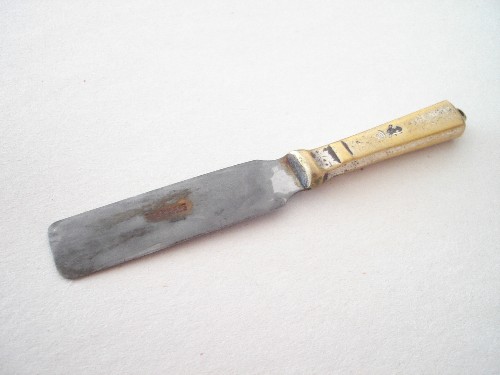 The
knife on the right was listed as a "1950 miniature mohel
knife from a well-known factory in Israel." The
original silver plating has worn off the handle.
The handle has a manufacturer's mark. The blade is
marked "stainless."
The
knife on the right was listed as a "1950 miniature mohel
knife from a well-known factory in Israel." The
original silver plating has worn off the handle.
The handle has a manufacturer's mark. The blade is
marked "stainless."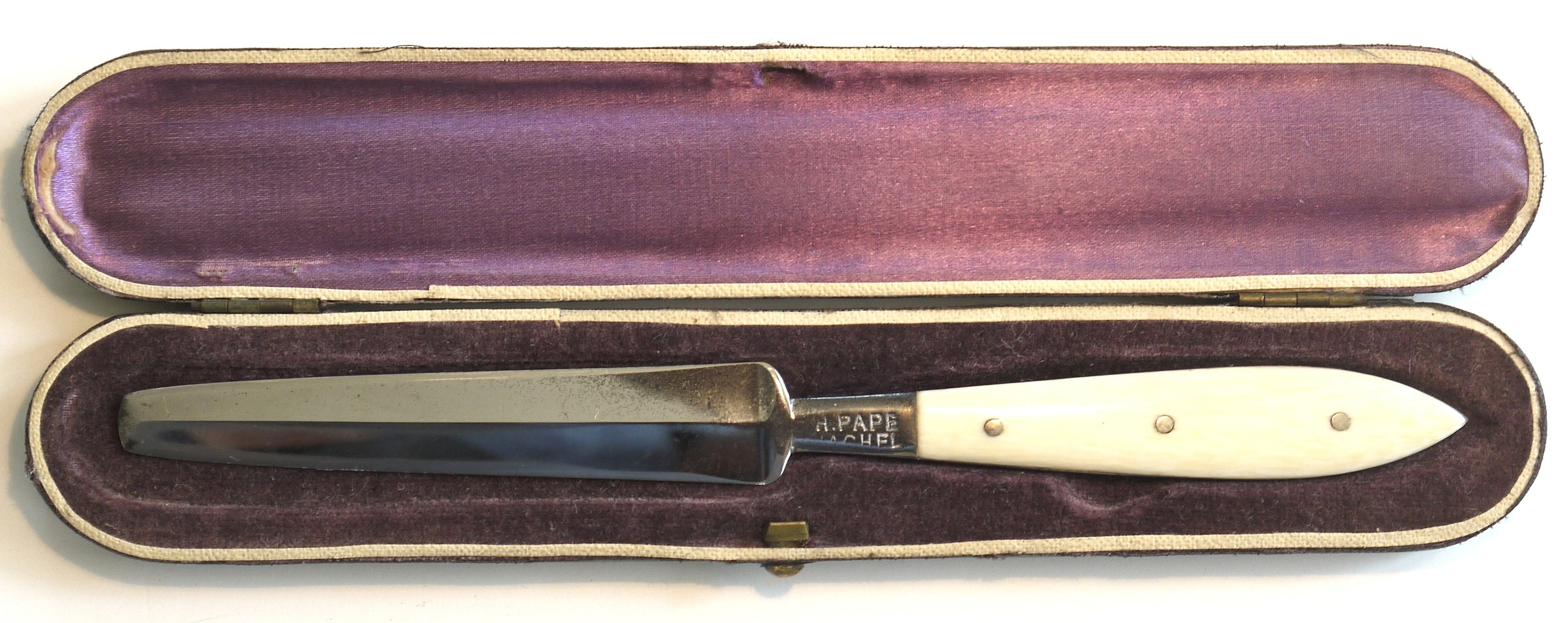 To the left is a circa
1890 circumcision knife. Its handle is
mother-of-pearl. The knife is marked on the
handle: H. PAPE/*ACHFL. It has a fitted
case.
To the left is a circa
1890 circumcision knife. Its handle is
mother-of-pearl. The knife is marked on the
handle: H. PAPE/*ACHFL. It has a fitted
case. Addendum: A kind person wrote to me about her shochet (butcher) knife marked with the same inscription. A little research revealed that this knife is from H. Pape Nachfl., a company that was located in Memel, East Prussia (now Klaipeda, Lithuania).
Below is a circumcision knife marked G. Grunewald, another late 1800s model.

 I found the
ad to the right in a 1914 phone directory. G.
Grunewald was a surgical supply company in Königsberg, East Prussia (now Kaliningrad, Russia).
I found the
ad to the right in a 1914 phone directory. G.
Grunewald was a surgical supply company in Königsberg, East Prussia (now Kaliningrad, Russia).
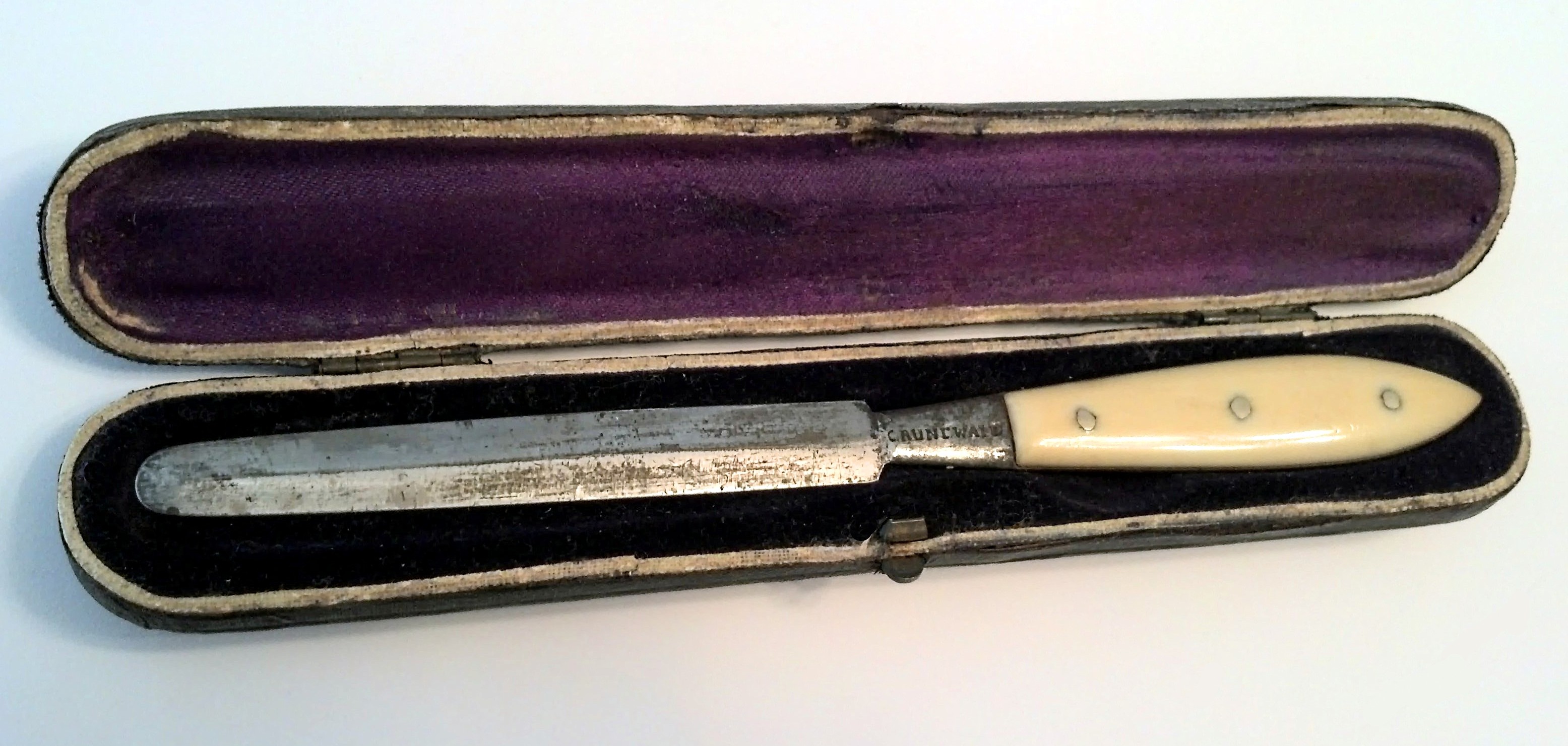 To the right is a knife marked simply
Grunewald, likely from the late 1800s. It
has a steel blade and an ivory handle. It is
unclear if G. Grunewald and Grunewald are the same
company.
To the right is a knife marked simply
Grunewald, likely from the late 1800s. It
has a steel blade and an ivory handle. It is
unclear if G. Grunewald and Grunewald are the same
company.
 To the right is yet another
knife similar to the ones above. The knife is stamped L.
Dimentschtein, and the box is labeled L. Dimentstein. If
someone knows the origin of this knife, please contact
me.
To the right is yet another
knife similar to the ones above. The knife is stamped L.
Dimentschtein, and the box is labeled L. Dimentstein. If
someone knows the origin of this knife, please contact
me. Here's a lesson: because the knife below resembles a circumcision knife, a Swedish antiques dealer contacted me.
Intrigued, I purchased the knife from him. Once I received the knife, I noticed a few things that seemed out of place--the embossing on the blade and the rounded corners of the blade where it meets the handle. These are not typical of circumcision knives.
I posted a photo on a knife discussion forum and quickly received an answer from knife expert Bernard Levine.
This is a Swedish paper knife, used in the 1800s and early 1900s to fold letters and cut open the pages of new books. It is a substantial knife, 7-3/4 inches long, with a nice ivory handle. The embossing, worn with age, is a nice, intricate design.
I'll sell it if someone is interested. Please contact me at CircCentral at yahoo dot com.
The mohel uses a circumcision shield (Hebrew: מָגֵן magen) to assist in removing the foreskin. Click the button below to see some examples of circumcision shields.
Copyright 2006-2025, Robert Lehrer, MD